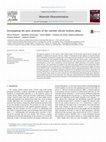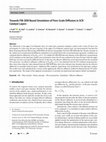Papers by Torsten Scherer
Nano Letters, Jul 27, 2023
Journal of Applied Crystallography, Feb 24, 2016
Fe-Al alloys in the aluminium range of 55-65 at.% exhibit a lamellar microstructure of B2-ordered... more Fe-Al alloys in the aluminium range of 55-65 at.% exhibit a lamellar microstructure of B2-ordered FeAl and triclinic FeAl 2 , which is caused by a eutectoid decomposition of the high-temperature Fe 5 Al 8 phase, the so-called " phase. The orientation relationship of FeAl and FeAl 2 has previously been studied by Bastin et al.

Materials Characterization, Nov 1, 2017
The physical properties of the calcium silicate hydrate phase (C-S-H) greatly impact material str... more The physical properties of the calcium silicate hydrate phase (C-S-H) greatly impact material strength and durability of cement-based materials. However, despite its widespread use and influence on material stability, there is still debate concerning its nanostructure. In this paper, the pore structure of C-S-H was characterized by analyzing focused ion beam prepared lamellas from a model tricalcium silicate clinker cement paste using scanning transmission electron microscopy (STEM) performed with a scanning electron microscope (SEM) for measurements at 30 keV and a transmission electron microscope (TEM) operating at low primary electrons energy (80 keV). The composition was mapped in the SEM using energy-dispersive X-ray spectroscopy (EDX). These investigations were accompanied by argon adsorption measurements using non-local density functional theory (NLDFT) models to calculate the pore size distribution. Mercury intrusion porosimetry (MIP) was used to investigate macropores. The STEM investigations performed at 30 and 80 keV both reveal a sponge-like pore structure built up by 0.7-4.0 nm thin C-S-H foils. The pore sizes range between 2 and 10 nm with a dominance of 5 nm wide pores. These results are in line with the pore size distribution determined with argon adsorption, which predominantly found 4.6 nm wide pores. The similar pore width distributions in STEM and gas adsorption validates the gas adsorption measurements and points towards minimal electron beam damage occurring during observation and analysis.
Electrochemical science advances, Jan 18, 2022
European Microscopy Congress 2016: Proceedings, Dec 20, 2016

Topics in Catalysis
The diffusivity in the upper Cu-Chabazite layer of a dual layer ammonia oxidation catalyst with a... more The diffusivity in the upper Cu-Chabazite layer of a dual layer ammonia oxidation catalyst with a lower Pt layer was investigated. In a first step, the pore structure of the upper Cu-Chabazite catalyst layer was determined by Focused Ion Beam-Scanning Electron Microscopy (FIB-SEM) slice&view tomography. From the FIB-SEM data the 3D pore structure of the catalyst was reconstructed and diffusion simulations were performed on the reconstructed pore geometry, resulting in an estimated effective diffusivity of Deff/Dgas = 0.31. To validate the FIB-SEM derived estimates of the diffusivity, measurements of CO oxidation on the dual layer catalyst were performed, where the CO was oxidized in the lower Pt-layer while the upper SCR layer served as an inactive diffusion barrier. In this way, the effective diffusivity can be determined from the measured CO conversion. An effective diffusion coefficient of Deff/Dgas = 0.11 was obtained from the CO oxidation measurements, three times lower than th...
Materials Letters, 2021
Abstract High-pressure torsion of a laminate consisting of a layer of monocrystalline molybdenum ... more Abstract High-pressure torsion of a laminate consisting of a layer of monocrystalline molybdenum sandwiched between two layers of copper was investigated. Computed tomography showed that at sufficiently large angles of rotation of the anvils the molybdenum layer loses planarity. It develops periodic folds and vortices, leading to ruptures. EBSD analysis revealed the formation of a blocky substructure in the molybdenum layer and a pronounced fragmentation of copper sheets, with the formation of a significant proportion of high-angle grain boundaries. The proposed mathematical model of the process accounts for the observed phenomena qualitatively. It is based on the gradient plasticity theory and predicts the loss of stability of the harder molybdenum layer when the shear strain in the laminate exceeds a critical value.
Journal of Materials Chemistry A, 2020
Optimization of SEI layer formation on Mg metal anodes of Mg/S batteries using iodine additive co... more Optimization of SEI layer formation on Mg metal anodes of Mg/S batteries using iodine additive containing Mg[B(hfip)4]2/DME electrolyte.

Materials Science and Engineering: A, 2019
An investigation was conducted on aluminum samples (AA1050) to study the microstructure and hardn... more An investigation was conducted on aluminum samples (AA1050) to study the microstructure and hardness evolution during processing by High Pressure Torsion Extrusion (HPTE). The equivalent strain accumulated in the samples after one pass of HPTE varied in a wide range between 0.9 and 65.5, depending on the processing parameters. HPTE led to the formation of a gradient microstructure in which the grain size decreased by increasing the distance from the central axis of the billets. This gradient decreased significantly by increasing the ratio of rotational speed to extrusion speed. Most of the grain refinement and hardness-increase occurred up to the equivalent strain of ~5 but saturation level was achieved at the strain of ~20. Saturation levels in grain size and hardness were ~0.7 µm and ~67 HV, respectively. HPTE technique can provide similar saturation in microstructure and hardness as those obtained by HPT but in much larger samples. Therefore, HPTE can be a named as a suitable candidate for practical applications to produce bulk ultrafine-grained materials with considerable enhancement in hardness.

Laser-based Micro- and Nanopackaging and Assembly VII, 2013
ABSTRACT The increasing need for long-life lithium-ion batteries requires the further development... more ABSTRACT The increasing need for long-life lithium-ion batteries requires the further development of electrode materials. Especially on the cathode side new materials or material composites are needed to increase the cycle lifetime. On the one hand, spinel-type lithium manganese oxide is a promising candidate to be used as cathode material due to its non-toxicity, low cost and good thermal stability. On the other hand, the spinel structure suffers from change in the oxidation state of manganese during cycling which is also accompanied by loss of active material into the liquid electrolyte. The general trend is to enhance the active surface area of the cathode in order to increase lithium-ion mobility through the electrode/electrolyte interface, while an enhanced surface area will also promote chemical degradation. In this work, laser microstructuring of lithium manganese oxide thin films was applied in a first step to increase the active surface area. This was done by using 248 nm excimer laser radiation and chromium/quartz mask imaging techniques. In a second step, high power diode laser-annealing operating at a wavelength of 940 nm was used for forming a cubic spinel-like battery phase. This was verified by means of Raman spectroscopy and cyclic voltammetric measurements. In a last step, the laser patterned thin films were coated with indium tin oxide (ITO) layers with a thickness of 10 nm to 50 nm. The influence of the 3D surface topography as well as the ITO thickness on the electrochemical performance was studied by cyclic voltammetry. Post-mortem studies were carried out by using scanning electron microscopy and focused ion beam analysis.

Nature Photonics, 2015
Implementing on-chip nonvolatile photonic memories has been a long-term, yet elusive goal. Photon... more Implementing on-chip nonvolatile photonic memories has been a long-term, yet elusive goal. Photonic data storage would dramatically improve performance in existing computing architectures 1 by reducing latencies associated with electrical memories 2 and potentially eliminating optoelectronic conversions 3. Furthermore, multi-level photonic memories with random access would allow for leveraging even greater computational capability 4-6. However, photonic memories 3,7-10 have thus far been volatile. Herein, we demonstrate a robust, nonvolatile, all-photonic memory based on phase-change materials. By utilizing optical near-field effects, we realize bit storage of up to eight levels in a single device that readily switches between intermediate states. Our on-chip memory cells feature single shot read-out and switching energies as low as 13.4pJ at speeds approaching 1GHz. We show that individual memory elements can be addressed using a wavelength multiplexing scheme. Our multi-level, multi-bit devices provide a pathway towards eliminating the von-Neumann bottleneck and portend a new paradigm in all-photonic memory and non-conventional computing.

ECS Journal of Solid State Science and Technology, 2014
For this study PbTe and PbSe thin film nanolaminates have been prepared on silicon substrates wit... more For this study PbTe and PbSe thin film nanolaminates have been prepared on silicon substrates with native oxide by Atomic Layer Deposition (ALD) using lead(II)bis(2,2,6,6-tetramethyl-3,5-heptanedionato) (Pb(C 11 H 19 O 2) 2), (trimethylsilyl) telluride ((Me 3 Si) 2 Te) and bis-(triethyl silyl) selane ((Et 3 Si) 2 Se) as ALD precursors for lead, tellurium and selenium. The experimental evidence revealed the ALD growth of lead telluride and lead selenide followed the Vollmer-Weber island growth mode. We found a strong dependence of the nucleation process on the temperature. In this paper, we present the optimized conditions for growing PbTe and PbSe thin film nanolaminates within the ALD process window range of 170 • C to 210 • C and discuss an early nano-scale PbTe/PbSe bilayer structure. Results of various physical characterizations techniques and analysis are reported.
Journal of Nanoparticle Research, 2014
This paper reports on the changes in the structural and morphological features occurring in a par... more This paper reports on the changes in the structural and morphological features occurring in a particular type of nanocomposite thin-film system, composed of Au nanoparticles (NPs) dispersed in a host TiO 2 dielectric matrix. The structural and morphological changes, promoted by in-vacuum annealing experiments of the as-deposited thin films at different temperatures (ranging from 200 to 800°C), resulted in a well-known localized surface plasmon resonance (LSPR) phenomenon, which gave rise to a set of different optical responses that can be tailored for a wide number of applications, including those for optical-based sensors. The results show that the annealing experiments enabled a gradual increase of the mean grain size of the Au NPs (from 2 to 23 nm), and changes in their distributions and separations

Physical Review B, 2012
Forced chemical mixing in nanostructured Ag 60 Cu 40 eutectic alloys during severe plastic deform... more Forced chemical mixing in nanostructured Ag 60 Cu 40 eutectic alloys during severe plastic deformation by high pressure torsion (HPT) was quantitatively studied using Xray diffraction, differential scanning calorimetry and transmission electron microscopy. Nearly complete chemical homogenization of the original lamellar structure with a wavelength of ≈ 165 nm was achieved after a shear strain of ≈ 350. The chemical mixing is accompanied by extensive grain refinement leading to nanocrystalline grains with average sizes of ≈ 42 nm. A Monte Carlo computer simulation model, which attributes mixing to dislocation glide, shows reasonable agreement with the experimental results. The model also shows that the characteristic strain for chemical homogenization scales linearly with the length scale of the system, L, and not with the square of the length scale, L 2 , as would be expected for Fickian diffusion.
Journal of Magnetism and Magnetic Materials, 2007
It is demonstrated that the atomic ordering of Co2FeSi can significantly be improved in terms of ... more It is demonstrated that the atomic ordering of Co2FeSi can significantly be improved in terms of magnetization and tunnel magnetoresistance using multilayered {Co2MnSi5nm/Co2FeSi5nm}10 full-Heusler magnetic electrodes in magnetic tunnel junctions.
Applied Clay Science, 2009
The alkaline fusion of volclay (a low-cost sodium exchanged smectite) was used as source to gener... more The alkaline fusion of volclay (a low-cost sodium exchanged smectite) was used as source to generate the Si and Al components which were effectively transformed into mesoporous Al-MCM-41 depending on hydrothermal condition. The Al-MCM-41 materials were investigated by powder X-ray diffraction (XRD), N2 adsorption–desorption measurements and both scanning electron microscopy (SEM) and environmental scanning electron microscopy (ESEM). The volclay which
Acta Materialia, 2009
The mechanical behaviour and microstructure evolution of nanocrystalline palladium was investigat... more The mechanical behaviour and microstructure evolution of nanocrystalline palladium was investigated. Material with an initial grain size ∼10nm was prepared by inert gas condensation. Instrumented high-pressure torsion straining was used to characterize the flow stress during plastic deformation to shear strains up to 300. A change in primary deformation mechanism was induced by stress-induced grain growth. For grain sizes <40nm, grain boundary mediated processes (shear banding, grain boundary sliding and grain rotation) controlled the deformation, with dislocation slip, twinning, and grain boundary diffusion providing the accommodation. For larger grain sizes, the operative deformation mechanism was dislocation slip.










Uploads
Papers by Torsten Scherer